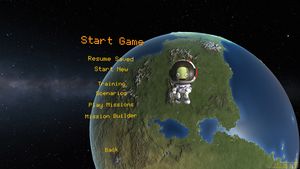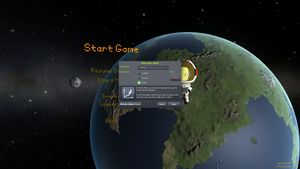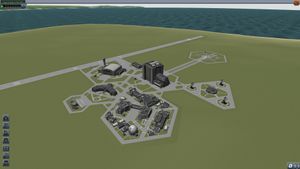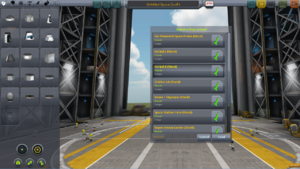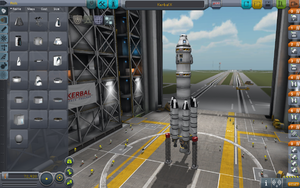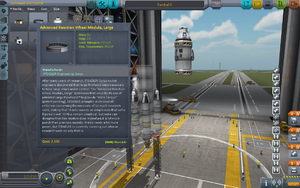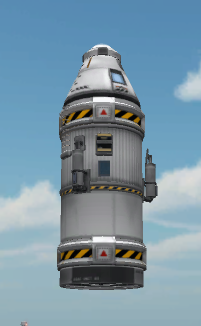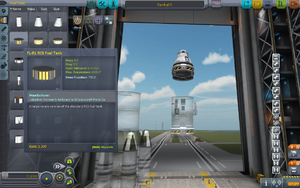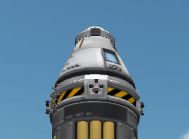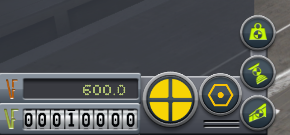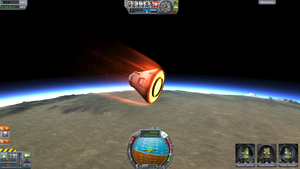Difference between revisions of "Getting Started"
(clean up formatting, typos fixed: in it's → in its, ie → i.e.) |
Mr. Kerbin (talk | contribs) m (→Running the Game) |
||
| (104 intermediate revisions by 34 users not shown) | |||
| Line 1: | Line 1: | ||
| − | This guide is intended to help you through your first few hours with Kerbal Space Program. It's far from comprehensive, but provides a decent understanding of the basics. | + | {{outdated}} |
| − | + | <div align="center"><big>''This guide is intended to help you through your first few hours with Kerbal Space Program. It's far from comprehensive, but provides a decent understanding of the basics as modifying and launching a rocket. The rest will be explored with your intuition or guidance of another tutorials''</big></div> | |
| − | + | ---- | |
| + | :''For an alternate walkthrough, including launching into orbit, see [[Tutorial: Walkthrough for Ye Compleat Beginner]].'' | ||
| + | :''For an overview of game mechanics, see [[Tutorial:Game Manual]].'' | ||
== Buying == | == Buying == | ||
| − | Squad provides a fairly | + | Squad provides a fairly straight forward storefront from which you can buy KSP. |
#Visit http://kerbalspaceprogram.com | #Visit http://kerbalspaceprogram.com | ||
| − | #Click on the store, there should be a program labeled “Kerbal Space Program” | + | #Create a new account or sign into your existing account |
| + | #Click on the store, there should be a program labeled “Kerbal Space Program” available for purchase. There are also two DLCs available for purchase: "Making History" and "Breaking Ground" | ||
<!-- I forgot ;_; --> | <!-- I forgot ;_; --> | ||
| − | Alternatively, one can buy KSP through [http://store.steampowered.com/app/220200/?snr=1_7_15__13 Steam] | + | Alternatively, one can buy KSP through [http://store.steampowered.com/app/220200/?snr=1_7_15__13 Steam], or some other smaller software distribution platform, such as [https://www.humblebundle.com/store/p/kerbalspaceprogram_storefront The Humble Store]. |
== Downloading == | == Downloading == | ||
| Line 27: | Line 30: | ||
#* Windows Users: | #* Windows Users: | ||
#*# Install .NET Framework 4.0 or above, if needed. (New versions of Windows already have it.) | #*# Install .NET Framework 4.0 or above, if needed. (New versions of Windows already have it.) | ||
| − | #*# Unzip the file into an '''empty folder''' that is '''not''' located under Program Files. A program like [ | + | #*# Unzip the file into an '''empty folder''' that is '''not''' located under Program Files. A program like [http://www.7-zip.org/ 7-zip] may be useful. |
#* Linux Users: | #* Linux Users: | ||
| − | #*# You already know what to do. | + | #*# You already know what to do, and the [[Linux|Linux-users help you]].<ref>http:////forum.kerbalspaceprogram.com/threads/24529-The-Linux-compatibility-thread!?highlight=linux+compatibility/ The-Linux-compatibility-thread</ref> |
== Running the Game == | == Running the Game == | ||
| − | Run the game after installing it by browsing to the folder into which the game was unpacked in and running KSP.exe (KSP.app on OSX, KSP.x86_64 or KSP.x86 on Linux depending on whether you wish to the run the 64 or 32bit versions). A shortcut can be made on the Desktop to this file to speed opening the game but is unnecessary if you want to run KSP from a USB drive to carry all of your game information with you for playing on any computer. | + | Run the game after installing it by browsing to the folder into which the game was unpacked in and running KSP.exe (KSP.app on OSX, KSP.x86_64 or KSP.x86 on Linux depending on whether you wish to the run the 64 or 32bit versions; we recommend running the 64bit version unless your computer is 32bit). A shortcut can be made on the Desktop to this file to speed opening the game but is unnecessary if you want to run KSP from a USB drive to carry all of your game information with you for playing on any computer. |
| − | [[File: | + | [[File:Gamestart.jpg|thumbnail|center|Figure 1 : KSP Main Screen]] |
The main screen has the following options: | The main screen has the following options: | ||
| − | # Start Game | + | # Start Game (Click this if you haven’t already.) |
| − | # [[Settings]] (This allows you to customize your settings, such as decreasing the graphics quality) | + | # [[Settings]] (This allows you to customize your settings, such as decreasing the graphics quality to improve performance) |
| − | # KSP Community | + | # KSP Community (this brings you to the KSP Forums) |
| − | # | + | # Addons & Mods (This brings you to the [http://www.curseforge.com/kerbal/ksp-mods Curse Network], where you can download [[addon]]s, but just use the forums, this area is outdated and may have malware!) |
| − | # Credits (This lists the developers of Kerbal Space Program) | + | # Credits (This lists the developers of Kerbal Space Program, It’s also really long so be advised) |
| − | # Quit ( | + | # Quit (Close the game, although opening it and immediately closing it is weird) |
By selecting the Start Game menu item, the Start and Load Game menu will appear. | By selecting the Start Game menu item, the Start and Load Game menu will appear. | ||
| − | [[File: | + | [[File:StartGameScreen.jpg|thumbnail|center|Figure 2 : Start / Resume Game Menu]] |
| + | |||
| + | Click the "Start New" button to start a new game. When starting a new game in [[Sandbox]] mode, which is what this article is assuming, the save game name does not have to remain 'default'. Change this to what ever name you want the save file to be. For the other options, see the [[Science mode|Science]] and the [[Career]] mode page. You can also change the [[Game Difficulty|Difficulty Settings]] here too. | ||
| − | + | Let's start a '''Sandbox''' mode game, and keep the difficulty settings as '''Normal'''! | |
| − | [[File: | + | [[File:Start New Game.jpg|thumbnail|center|Figure 3 : New Game Window]] |
| − | Once the new game is started, the [[Kerbal Space Center | + | Once the new game is started, the [[Kerbal Space Center]] (KSC) will appear with the following facilities: |
| − | * [[Vehicle Assembly Building]] (VAB) - Build and save vertically launched [[rocket]]s | + | * [[Vehicle Assembly Building]] (VAB) - Build and save vertically launched [[rocket]]s. |
| − | * [[ | + | * [[Spaceplane Hangar]] (SPH) - Build and save horizontally launched [[plane]]s. |
| − | * [[Tracking Station]] - Track and go to flights in progress, manage debris | + | * [[Tracking Station]] - Track and go to flights in progress, manage debris. |
| − | * [[Astronaut Complex]] - | + | * [[Astronaut Complex]] - Hire new crew and view existing crew. |
| − | * [[Launch | + | * [[Flag Pole]] - Change the default flag for new launches. |
| − | * [[Research and Development| | + | * [[Launch Pad]] - Launch vertical rockets. |
| − | + | * [[Runway]] - Launch and land airplanes. | |
| + | * [[Research and Development]] - Unlock new technology (available in [[Science mode|Science]] and [[Career]] modes only). | ||
| + | * [[Mission Control]] - Controlling missions, getting [[contract]]s (available in [[Career]] mode only). | ||
| + | * [[Administration Building]] - Changing the business [[strategies]] (available in [[Career]] mode only). | ||
| + | To access a facility, just click on it, or its icon | ||
| − | + | The director (Gene Kerman) of the installation will greet you giving some tutorials at the each first time you visit an important installation. Read it if you want, and click on the "'''''Thanks, I've got it'''''" button bellow. | |
| + | [[File:KSC main.jpg|thumbnail|center|Figure 4 : The Space Center]] | ||
| − | [[File: | + | == Building A Rocket == |
| + | [[File:VAB icon.png|left|link=]]Since a rocket is needed, select the tall, square structure, about in the middle of the [[KSC]](or click on the building with the rocket inside at the row of buttons on the bottom left corner of your screen), it will say [[Vehicle Assembly Building]]. From here we will build our first rocket! | ||
| − | + | [[File:KerbalXstock.0.21.1.png|thumbnail|center|Figure 5 : Assembly Menu]] | |
| − | [[File: | + | [[File:Load icon.png|left|link=]] Selecting the Orange Folder in the top right section of the window opens the menu shown in Figure 5. Find and select the [[Kerbal X]] (stock) to load it up. This [[rocket]] is fairly simple and can easily achieve orbit around the planet. If you are using the demo version, [http://dl.dropbox.com/u/27588455/Jam001.craft Here] is a simple rocket that can achieve orbit with more than enough fuel for returning to the planet. If you prefer to build the rocket yourself check out this tutorial to [[Tutorial:Basic Rocket Design|learn how to build a rocket capable of reaching orbit]]. Try to make sure you have at least 3,500 m/s of fuel and an aerodynamic rocket. Once you are done building, come back here and jump to the "Launching the rocket" section to learn how to fly your marvelous creation. |
| − | + | [[File:TheKerbalX.png|thumbnail|center|Figure 6 : The Kerbal X]] | |
| − | [[File: | + | [[File:Assemblymodes_icons.png|left|link=]] |
| + | As the craft is loaded the editor gizmos appear (they are visible when the first part is placed). They are '''''Place''''', '''''Offset''''', '''''Rotate''''' and '''''[[root part|Root]]''''' in order, and they changes the behavior of the editor. The editing method can be changed with left-mouse-clicking on the the selected method's icon or using the equivalent {{Key press|1|2|3|4|chain=}} keystrokes. While we are learning the bases of the game in this tutorial, we will use the ''place'' method only, the rest of them will be detailed later. | ||
| − | This rocket is | + | <br> |
| + | This rocket is very simple and easy to explain. On the right side of the screen, shown in Figure 6, are orange folders that have numbers ranging from 0 to 8. These are the rocket's launch [[stage]]s. Launch stages differ from rocket stages in that launch stages are events that each {{Key press|spacebar}} press triggers. Each stage contains at least one icon; each icon symbolizes an event of that stage. The launch stages are(note that stage 8 will come before stage 7): | ||
# Rocket Launch Stage 8 | # Rocket Launch Stage 8 | ||
| Line 87: | Line 100: | ||
# Rocket Launch Stage 5 | # Rocket Launch Stage 5 | ||
#* After a short while two more engines will run out, and pressing the spacebar will activate this stage to release them from the rocket. | #* After a short while two more engines will run out, and pressing the spacebar will activate this stage to release them from the rocket. | ||
| − | #** Again, trigger this stage only | + | #** Again, trigger this stage only after two more engines have run out of fuel |
# Rocket Launch Stage 4 | # Rocket Launch Stage 4 | ||
#* The same as the previous two launch stages | #* The same as the previous two launch stages | ||
| Line 100: | Line 113: | ||
#** Release the last engines; activate upon falling towards the planet | #** Release the last engines; activate upon falling towards the planet | ||
# Rocket Launch Stage 0 | # Rocket Launch Stage 0 | ||
| − | #* Deploys the parachute. | + | #* Deploys the [[parachute]]. |
| − | That is the run down of the orange tabs on the right side of the screen. | + | That is the run down of the orange tabs on the right side of the screen. While there is nothing that really *needs* to be done to the Kerbal X Rocket, I strongly advise adding a couple of items that will make getting into orbit a bit easier. To change the order of the staging events click them, and if the parts they represent are placed in symmetry, it will expand. Use {{Key press|Crtl}} left mouse button click (On Windows) to select multiple icons, and drag them into the desired stage. |
| − | [[File:SASLarge | + | [[File:SASLarge.png|thumbnail|center|Figure 7 : Preparing for the SAS module]] |
| − | Figure 7 shows the main rocket stage removed in preparation of the black SAS module, from the Control Tab, that will be added. To "break" the rocket in the correct place, simply point your mouse at the section below the separator ring, the black and yellow ring with the red square on it, and do a left-mouse-click (LMC) once. This selects the fuel cell that is underneath of the separator ring and everything below that section of the rocket. Then simply move it out of the way, *but not into the grey component selections on the left* or else it will be trashed, and do another LMC to place the rocket components there. | + | Figure 7 shows the main rocket stage removed in preparation of the [[Advanced S.A.S Module, Large|black SAS module]], from the Control Tab, that will be added. To "break" the rocket in the correct place, simply point your mouse at the section below the [[Rockomax Brand Decoupler|separator ring]], the black and yellow ring with the red square on it, and do a left-mouse-click (LMC) once. This selects the fuel cell that is underneath of the separator ring and everything below that section of the rocket. Then simply move it out of the way, *but not into the grey component selections on the left* or else it will be trashed, and do another LMC to place the rocket components there. |
| − | The SAS module will help greatly in | + | The [[SAS]] module will help greatly in spinning your rocket around as it provides torque. A simple keypress {{Key press|T}}, after the rocket is moved out to the launchpad, will allow the rocket to stay almost perfectly centered while it is in flight. There are other concerns for keeping the rocket stable but those will be covered later. |
| − | [[File:SASaddedFirstStage | + | [[File:SASaddedFirstStage.png|thumbnail|center|Figure 8 : The SAS Added to the Main Rocket Stage]] |
| − | In order to add the SAS module, do an LMC on the black SAS module, then move your cursor over to the rocket sections. There should now be the SAS module following your cursor, and if not simply go back and do another LMC to select the module again. With the module following your cursor, drag it to the base of the | + | In order to add the SAS module, do an LMC on the black SAS module, then move your cursor over to the rocket sections. There should now be the SAS module following your cursor, and if not simply go back and do another LMC to select the module again. With the module following your cursor, drag it to the base of the decoupler ring and you will see the SAS turn green when it is properly placed. Do one last LMC and the module will be placed underneath the decoupler as shown in Figure 8. The last step is to combine the lower section back onto the SAS module. This is done the same way as it was taken off, just in reverse. |
| − | [[File:RCSFuelLarge | + | [[File:RCSFuelLarge.png|thumbnail|center|Figure 9 : Selecting the RCS Module]] |
| − | Another SAS module can be added to the section directly underneath the capsule. Simply repeat the same process to the separator that is underneath the capsule. While adding the SAS to the Capsule section, adding some RCS Fuel, Figure 9, will also assist in keeping the rocket stable in flight, by pressing | + | Another SAS module can be added to the section directly underneath the capsule. Simply repeat the same process to the separator that is underneath the capsule. While adding the SAS to the Capsule section, adding some [[RCS]] Fuel, Figure 9, will also assist in keeping the rocket stable in flight, by pressing {{Key press|R}} to turn on the rocket in flight. The last step is to add some RCS thrusters like the [[RV-105 RCS Thruster Block]], which I added to the capsule decoupler ring, see Figure 10. To add these thrusters in any sort of symmetry, use the symmetry icon in the bottom left of the screen, see Figure 11. Each LMC on this indicator will cycle through all of the cloning options, i.e. 1 - 8 duplicates of whatever item you are placing. |
| − | [[File:RCSAdded | + | [[File:RCSAdded.png|thumbnail|center|Figure 10 : RCS Thrusters Added to the Capsule Separator Ring]] |
| − | [[File:SymmetryIndicator | + | [[File:SymmetryIndicator.png|thumbnail|center|Figure 11 : The Symmetry Indicator]] |
| − | Once the rocket is all attached together again, it is time to move the rocket to the launch pad. Referring back to Figure | + | Once the rocket is all attached together again, it is time to move the rocket to the launch pad. Referring back to Figure 6, the Launch Pad is the green icon in the upper right corner of the screen. Clicking on this icon will move the rocket onto the launch pad. |
==Launching the rocket== | ==Launching the rocket== | ||
| − | + | ====About the stages shortly==== | |
| + | It's time learn more about your rocket. The parts editor in the [[VAB]] is simple enough to use, but if I were you I would stay away from [[spaceplane]]s for a little while longer. | ||
| + | |||
| + | You already know a little bit about staging, but I'm going to generalize it even more for you. | ||
| + | |||
| + | =====The launch stage===== | ||
| + | This part of the rocket is usually called [[launch vehicle]]. Here you have a whole bunch of high powered engines and large fuel tanks, [[Solid rocket booster]]s are most often used here. The motto here is pack as much of it on as you can because you're not taking it with you. | ||
| + | |||
| + | If you do not already know, you can mount things radially (on the side) of other things, and by the magic of the symmetry button (Bottom of the parts menu) you can have the radially mounted things not make your poor rocket tip over. | ||
| + | |||
| + | Staging is one of the most important aspects of building a rocket, even though a lot of people have quickly traded it in for action groups. On the right there is a tall bar with everything in its respective stage, however if you were to put half your rockets in one stage and the other half in another, you would go almost 3 times as far, in twice the time! | ||
| − | + | =====The other stages===== | |
| − | + | Generally split into a circularization stage (I totally didn't make that word up), and an interplanetary stage. For now all you really need to know is everything after the stages in the [[atmosphere]] should be light, with medium to low power. Once you're out, if you're going into orbit all you need is a [[LV-N Atomic Rocket Motor|LV-N]], [[LV-909 Liquid Fuel Engine|909]] or a [[Rockomax "Poodle" Liquid Engine|Poodle]], depending on your preference. | |
| − | + | ---- | |
| + | [[File:Launch icon.png|left|link=]] Once you've made or selected a rocket, press the big green "'''[[Launch]]'''" button in the top right. This deploys the rocket created in the VAB on the [[Launch Pad]], where we can start our brief mission, which contains a taking off, a getting into orbit and a return. | ||
| + | {{clear}} | ||
| + | ====Control==== | ||
| + | Flight controls are not exactly straightforward. {{Key press|W|S|A|D|chain=}} move the ship around, but they are relative to your rotation, controlled with {{Key press|Q}} and {{Key press|E}}. The easiest way to keep your rocket on target with {{Key press|W|S|A|D|chain=}} is to look at the [[navball]], in the bottom middle of the screen. | ||
| − | + | Before launching your rocket, take a second to look at your [[map view|map]], by pressing {{Key press|M}}. This will bring up [[Kerbin]] on the map. Scroll out to show kerbins moons, and even farther to see the rest of the solar system. It will be a while before you even learn how to make a rocket than can escape the [[sphere of influence]] of Kerbin, so experiment with different rocket designs, and see what works best for you. The craft is driveable in map view if navball is popped up from the bottom middle, although the staging is mot working in this case. The navball holds its position, so it is better to leave it popped up state before launching. | |
| − | If you don't | + | [[File:Resource icon.png|left|link=]] If you want to keep an eye on the [[resource]]s of the craft, click on the jerry can icon on top left corner. This displays the resources of the vehicle. The [[reaction engine/hu|rocket engines]] of this rocket consume '''''[[oxidizer]]''''' and '''''[[liquid fuel]]'''''. If one of those resources are depleted the engines will flame out. |
| + | {{clear}} | ||
| + | Launching your rocket is the easy part. Just [[throttle]] up with left-shift and press space. But don't do that just yet, press {{Key press|T}} to turn SAS on. SAS is essentially autopilot, without SAS you just won't turn as well. The SAS allows you to control the movement of your rocket with the {{Key press|W|S|A|D|Q|E|chain=}} keys faster, and with more power, and allows your rocket to use [[thrust vectoring]] (You'll learn about that later too) and it keeps you on course, instead of you having to turn manually. If the SAS is activated the [[direction selector]] table appears on the left of navbal. Some directions possible to be chosen on this table. Let it on the default '''''Stability Assist''''' for now. | ||
| − | + | Each time you run out of fuel in a stage, press {{Key press|space}} until the next stage of fuel and engines start burning. | |
| − | + | If you have messed up something, or just want to pause the game (for example: reading the wiki), press the {{Key press|Esc}} button. This pauses the game, and pops up a menu with the following options: | |
| + | * '''''Resume Flight''''' - you can continue the paused game without any other action | ||
| + | * '''''Space Center''''' - this drops you to the space center building selector menu (not available during the flight) | ||
| + | * '''''Revert Flight''''' - aborts the flight, returns to an earlier state | ||
| + | ** '''''Revert to Launch''''' - reverts the game to just before the launching | ||
| + | ** '''''Revert to Vehicle Assembly''''' - leads you back to the [[editor]] in the VAB | ||
| + | ** '''''Cancel''''' - back to the previous menu (what else) | ||
| + | * '''''Settings''''' - opens the [[settings]] menu. | ||
| − | + | ==== Execution ==== | |
| + | If you don't want to read everything I said above all you need to know is before launching press {{Key press|T}}, hold left-shift until the throttle is at maximum, then press {{Key press|space}} to launch and if your rocket stops going, press {{Key press|space}} again. | ||
| − | + | You can also imitate the real-life launches, execute a slow [[gravity turn]]. The main point the gravity turn is the engines can spend all of their thrust to increase the speed and fight against the gravity and drag, turning of velocity vector (this is basically a wasted work) made by gravity on a trajectory minimizes the loss by aerodynamic drag and gravity. It saves a lot of fuel during ascent. As I mentioned, the essence of gravity turn: the rocket always flies towards the heading - this direction called [[prograde]] and designated on the navball by this mark: {{mark|prog-l}}. During the ascent keep the level indicator in the middle of the navball nearby the prograde mark. And keep an eye on the proper speed - as the [[atmosphere#Terminal velocity|terminal velocity]] is reached, just keep the acceleration around the 2 g avoiding the too great [[drag]] and the too steep trajectory. | |
| − | |||
| − | + | The first step is ascending vertically - this sequence usually called vertical climb. This is needed to gain altitude and speed and pass the dense region of the atmosphere causing high drag - fast and at low fuel cost. Excelling at the speed of 50-60 m/s and approaching to the altitude of 250 ms pitch over with angle of ~10 degrees (relative to vertical) to east (this is called pitchover maneuver), and after this maneuver just <u>slowly, gently and continuously</u> increase the angle following the prograde mark, while keeping a heading of 90 degrees east, giving a tilt of 30 degrees at 5 km but do not give greater tilt over 45° until reach 10 km. At this altitude you can turn down the throttle a bit, and start increasing (slowly, gently and continuously) the pitch to 25-30 degrees above the artificial horizon, over 20 km altitude increase the tilt over ~15 degrees at 30 km, and the heading will differ to horizontal less at 40 kms altitude, but as you pass altitude of 30 km and separated the last stage of the launch rocket, switch to map view. Pop up the navball to keep the rocket steerable - although the staging won't work in this state. Turn down the [[throttle]] a bit (left-{{Key press|Control}}), follow the direction and keep an eye on the [[Orbit#Apoapsis and periapsis|apoapsis]] (marked with "'''Ap'''" on the map) till 70 km is reached. When it is reached turn off the throttle (left-{{Key press|Control}}) or press the {{Key press|X}}. This needs speed of 1500-2000 m/s relative to '''''orbit''''' (or 1325-1825 m/s relative to '''''surface''''' ''(see: [[navball#Point of reference|Point of reference]]'') on a right trajectory, but less is enough on less efficient steeper trajectory). Remember: the too shallow trajectory wastes the fuel for drag, the too steep for the gravity ''(note: differing to the shallower is a bit more dangerous to the steeper)''. Don't forget: the good trajectory is clean and continuous. | |
| − | + | <gallery class="center" heights=100px widths=150px> | |
| + | File:KerbalXLaunch00.jpg|On the launchpad | ||
| + | File:KerbalXLaunch01.jpg|Ready to launch | ||
| + | File:KerbalXLaunch02.jpg|Launching | ||
| + | File:KerbalXLaunch03.jpg|The first staging | ||
| + | File:KerbalXLaunch04.jpg|The pitchover maneuver | ||
| + | File:KerbalXLaunch05.jpg|At altitude of 10 km | ||
| + | File:KerbalXLaunch06.jpg|At altitude of 20 km | ||
| + | File:KerbalXLaunch07.jpg|At altitude of 30 km | ||
| + | File:KerbalXLaunch08.jpg|Reaching the orbit | ||
| + | File:KerbalXLaunch09.jpg|Ready to burn | ||
| + | File:KerbalXLaunch10.jpg|The circular orbit | ||
| + | </gallery> | ||
| − | + | The fuel saving of the proper launch and gravity turn can reach several hundred m/s [[delta-v|Δv]]. The another benefit of the precise gravity turn induces less stress of the rocket-body - so less stability improvement (SAS,RCS, [[winglet]]s on the bottom of the rocket) and strengthening struts are needed for the rocket, which makes the rocket cheaper, and results better weight ratio and improved efficiency. The higher horizontal speed of a properly shallow trajectory also makes the circularization easier, as here is much lower extra-speed had to be added during the procedure. That is why the gravity turn worth to learn well. | |
| − | + | ==Getting into orbit and return== | |
| − | === | + | ====Getting into orbit==== |
| + | Remember when I told you how to open the map? That's going to come in handy here. Your map also shows your orbital details, so what you need to do is burn just about directly up with your launcher stage. This may take a while, and I encourage you <u>NOT</u> to use the [[physics warp]] as with most rockets if you are burning as using the physics warp will almost always make you veer wildly off course or explode in midair. Once your apoapsis (marked with "'''Ap'''" on the map) is above about 70 km, press {{Key press|X}} or hold left-{{Key press|Control}} to turn off your throttle. On the navball the marker indicating your direction should be right on the border between blue and brown. Turn SAS back on and time warp (slowly) until your rocket is about 10 seconds to reach apoapsis, then start burning. The most efficient method if you feed your rockets with small doses keeping the apoapsis front of your rocket with few (~2-5) seconds. The proper time for reactivating engines depends on the acceleration of the rocket and the trajectory. The shallower trajectory needs less extra speed, the better acceleration gives you more freedom. This Kerbal X with nearly empty tanks will accelerates quite a well. On the map your orbit should get wider and wider, and once it gets wide enough your periapsis will pop out of the ground, see its shadow and go scampering off into space. Once your apoapsis and periapsis (marked with "'''Pe'''" on the map) are both above 70km, you can rest and look at your work. | ||
| − | + | You can bring up your navball on the map, by clicking on the small arrow on the hiding navball's top for controlling the craft, and see your '''''[[resource]]s''''' on the map by clicking on the jerrycan. Pressing the {{Key press|F2}} hides/displays the whole GUI. | |
| − | + | ====Orbiting and reentry==== | |
| + | [[File:Kerbal X fire ret.png|thumb|Returning to Kerbin (This image is outdated. You should make sure you have a heat shield before re-entering.)]] | ||
| + | Then you can start thinking "Great, I have a piece of junk in orbit of my planet." To reenter Kerbin, you need to burn [[retrograde]]. That sounds fancy, but if you have enough fuel just turn your rocket until you see the green circle with a cross in the middle: {{mark|retg-l}}. Point directly at it and burn. You do not have to aim the landing site, even not the ground, because the atmospheric drag modifies the trajectory. It is enough to lower the periapsis of a low circular orbit to 35-40 km. This altitude ensures effective [[aerobraking]], but avoids the damage of the craft. The position of the landing site can be operated with the timing of the braking. In case of a 70 kms high circular orbit the landing site is approximately under that 35-40 km high periapsis. | ||
| − | + | === Re-Entry Heating === | |
| + | As of KSP 1.0, you have to worry about re-entry heating. As your rocket (just the capsule and parachute in this instance) re-enters, it generates heat because it is pushing air molecules out of the way at a very high speed. Rub your hands together and you will see what I mean. The pressure change mostly contributes to the re-entry effect... So, obviously, unless you are attempting to roast your little green crew-members, you need to make sure your craft has adequate heat shielding. To find a heat shield, click on the "Thermal" Tab and choose a heat shield that fits your craft. | ||
| − | |||
| − | + | | The parachute can semi-deploy at altitude of 22 km - in this state it works as drogue chute - and fully deploy {{Formatnum|1000}} m above the ground by default, and if you made your top stage light enough it will almost completely stop you before you hit the ground. It is worth to open the chute far before the full deployment altitude, because the semi-deployed chute still effectively lowers the speed. If your returning unit is too fast and too heavy, the suddenly full-deploying parachute will rip off and your [[kerbal]]s will fall to the ground, exploding upon impact. So, let the cabin slow down under 350 m/s before safely opening the chute. This will indicated by its icon's color turning gren from red meaning that it is now safe to open the parachute. If the parachute has already opened and your capsule descending slowly, just wait for reaching the surface. If the capsule landed on ground or splashed-down, move your mouse on the altimeter in top-center on the screen and click on the popped down green '''''RECOVER VESSEL''''' button to [[Recovery|recover]] the pod. Congratulations, you have successfully finished your first space mission! | |
| + | <br><br> | ||
| + | :''If you can do the previous simple mission (launch-getting to orbit-returning) confidently with a default Kerbal-X (or an own self-made rocket), it is the high time to [[Tutorial:Learning basics of rocket building|learn the editor and the basics of rocket building]] or move to the [[tutorials]] page where you may find many secrets of ship-building, mission planing and maneuvering.'' | ||
| − | + | == Notes == | |
| + | <references /> | ||
| + | [[Category: Tutorials]] | ||
Latest revision as of 04:42, 1 July 2024
| This page or section is in need of being brought up to date. Please help Kerbal Space Program Wiki by fixing inaccurate or outdated information. |
- For an alternate walkthrough, including launching into orbit, see Tutorial: Walkthrough for Ye Compleat Beginner.
- For an overview of game mechanics, see Tutorial:Game Manual.
Contents
Buying
Squad provides a fairly straight forward storefront from which you can buy KSP.
- Visit http://kerbalspaceprogram.com
- Create a new account or sign into your existing account
- Click on the store, there should be a program labeled “Kerbal Space Program” available for purchase. There are also two DLCs available for purchase: "Making History" and "Breaking Ground"
Alternatively, one can buy KSP through Steam, or some other smaller software distribution platform, such as The Humble Store.
Downloading
Currently, the entirety of the current version of Kerbal Space Program is downloaded at once. There are plans for a Patcher, and the Steam version handles this automatically.
- Go to the store.
- Log in with your username and password.
- Click on the Profile button.
- Scroll down to the bottom and select the download link next to the purchase invoice.
- Download the version for your platform.
- Mac users:
- Install Mono from the bundled .dmg file, if needed.
- Unzip the file into an empty folder.
- Ensure the execute permission is set on the Patcher.command file.
- Windows Users:
- Install .NET Framework 4.0 or above, if needed. (New versions of Windows already have it.)
- Unzip the file into an empty folder that is not located under Program Files. A program like 7-zip may be useful.
- Linux Users:
- You already know what to do, and the Linux-users help you.[1]
- Mac users:
Running the Game
Run the game after installing it by browsing to the folder into which the game was unpacked in and running KSP.exe (KSP.app on OSX, KSP.x86_64 or KSP.x86 on Linux depending on whether you wish to the run the 64 or 32bit versions; we recommend running the 64bit version unless your computer is 32bit). A shortcut can be made on the Desktop to this file to speed opening the game but is unnecessary if you want to run KSP from a USB drive to carry all of your game information with you for playing on any computer.
The main screen has the following options:
- Start Game (Click this if you haven’t already.)
- Settings (This allows you to customize your settings, such as decreasing the graphics quality to improve performance)
- KSP Community (this brings you to the KSP Forums)
- Addons & Mods (This brings you to the Curse Network, where you can download addons, but just use the forums, this area is outdated and may have malware!)
- Credits (This lists the developers of Kerbal Space Program, It’s also really long so be advised)
- Quit (Close the game, although opening it and immediately closing it is weird)
By selecting the Start Game menu item, the Start and Load Game menu will appear.
Click the "Start New" button to start a new game. When starting a new game in Sandbox mode, which is what this article is assuming, the save game name does not have to remain 'default'. Change this to what ever name you want the save file to be. For the other options, see the Science and the Career mode page. You can also change the Difficulty Settings here too.
Let's start a Sandbox mode game, and keep the difficulty settings as Normal!
Once the new game is started, the Kerbal Space Center (KSC) will appear with the following facilities:
- Vehicle Assembly Building (VAB) - Build and save vertically launched rockets.
- Spaceplane Hangar (SPH) - Build and save horizontally launched planes.
- Tracking Station - Track and go to flights in progress, manage debris.
- Astronaut Complex - Hire new crew and view existing crew.
- Flag Pole - Change the default flag for new launches.
- Launch Pad - Launch vertical rockets.
- Runway - Launch and land airplanes.
- Research and Development - Unlock new technology (available in Science and Career modes only).
- Mission Control - Controlling missions, getting contracts (available in Career mode only).
- Administration Building - Changing the business strategies (available in Career mode only).
To access a facility, just click on it, or its icon
The director (Gene Kerman) of the installation will greet you giving some tutorials at the each first time you visit an important installation. Read it if you want, and click on the "Thanks, I've got it" button bellow.
Building A Rocket
As the craft is loaded the editor gizmos appear (they are visible when the first part is placed). They are Place, Offset, Rotate and Root in order, and they changes the behavior of the editor. The editing method can be changed with left-mouse-clicking on the the selected method's icon or using the equivalent 1234 keystrokes. While we are learning the bases of the game in this tutorial, we will use the place method only, the rest of them will be detailed later.
This rocket is very simple and easy to explain. On the right side of the screen, shown in Figure 6, are orange folders that have numbers ranging from 0 to 8. These are the rocket's launch stages. Launch stages differ from rocket stages in that launch stages are events that each spacebar press triggers. Each stage contains at least one icon; each icon symbolizes an event of that stage. The launch stages are(note that stage 8 will come before stage 7):
- Rocket Launch Stage 8
- Initial launch stage
- Seven Liquid Fuel Thrusters.
- Rocket Launch Stage 7
- Second launch stage
- Releases the support braces, called TT18-A Launch Stability Enhancers, at the bottom of the Kerbal X Rocket (the open frame supports capped with the red cap)
- Rocket Launch Stage 6
- This, the third, launch stage releases two of the boosters from the main rocket
- Trigger this stage only after the first set of two boosters are out of fuel
- Audio and visual cues indicate that a rocket engine is out of fuel
- This, the third, launch stage releases two of the boosters from the main rocket
- Rocket Launch Stage 5
- After a short while two more engines will run out, and pressing the spacebar will activate this stage to release them from the rocket.
- Again, trigger this stage only after two more engines have run out of fuel
- After a short while two more engines will run out, and pressing the spacebar will activate this stage to release them from the rocket.
- Rocket Launch Stage 4
- The same as the previous two launch stages
- However, it is the last set of the booster engines.
- The same as the previous two launch stages
- Rocket Launch Stage 3
- The end of the first stage of the rocket
- Pressing the spacebar separates the main engine that helped the boosters get the rocket into space from the second stage of the rocket.
- The end of the first stage of the rocket
- Rocket Launch Stage 2
- Activates the smaller engine attached directly to the capsule
- Rocket Launch Stage 1
- The last stage before the parachute is opened
- Release the last engines; activate upon falling towards the planet
- The last stage before the parachute is opened
- Rocket Launch Stage 0
- Deploys the parachute.
That is the run down of the orange tabs on the right side of the screen. While there is nothing that really *needs* to be done to the Kerbal X Rocket, I strongly advise adding a couple of items that will make getting into orbit a bit easier. To change the order of the staging events click them, and if the parts they represent are placed in symmetry, it will expand. Use Crtl left mouse button click (On Windows) to select multiple icons, and drag them into the desired stage.
Figure 7 shows the main rocket stage removed in preparation of the black SAS module, from the Control Tab, that will be added. To "break" the rocket in the correct place, simply point your mouse at the section below the separator ring, the black and yellow ring with the red square on it, and do a left-mouse-click (LMC) once. This selects the fuel cell that is underneath of the separator ring and everything below that section of the rocket. Then simply move it out of the way, *but not into the grey component selections on the left* or else it will be trashed, and do another LMC to place the rocket components there.
The SAS module will help greatly in spinning your rocket around as it provides torque. A simple keypress T, after the rocket is moved out to the launchpad, will allow the rocket to stay almost perfectly centered while it is in flight. There are other concerns for keeping the rocket stable but those will be covered later.
In order to add the SAS module, do an LMC on the black SAS module, then move your cursor over to the rocket sections. There should now be the SAS module following your cursor, and if not simply go back and do another LMC to select the module again. With the module following your cursor, drag it to the base of the decoupler ring and you will see the SAS turn green when it is properly placed. Do one last LMC and the module will be placed underneath the decoupler as shown in Figure 8. The last step is to combine the lower section back onto the SAS module. This is done the same way as it was taken off, just in reverse.
Another SAS module can be added to the section directly underneath the capsule. Simply repeat the same process to the separator that is underneath the capsule. While adding the SAS to the Capsule section, adding some RCS Fuel, Figure 9, will also assist in keeping the rocket stable in flight, by pressing R to turn on the rocket in flight. The last step is to add some RCS thrusters like the RV-105 RCS Thruster Block, which I added to the capsule decoupler ring, see Figure 10. To add these thrusters in any sort of symmetry, use the symmetry icon in the bottom left of the screen, see Figure 11. Each LMC on this indicator will cycle through all of the cloning options, i.e. 1 - 8 duplicates of whatever item you are placing.
Once the rocket is all attached together again, it is time to move the rocket to the launch pad. Referring back to Figure 6, the Launch Pad is the green icon in the upper right corner of the screen. Clicking on this icon will move the rocket onto the launch pad.
Launching the rocket
About the stages shortly
It's time learn more about your rocket. The parts editor in the VAB is simple enough to use, but if I were you I would stay away from spaceplanes for a little while longer.
You already know a little bit about staging, but I'm going to generalize it even more for you.
The launch stage
This part of the rocket is usually called launch vehicle. Here you have a whole bunch of high powered engines and large fuel tanks, Solid rocket boosters are most often used here. The motto here is pack as much of it on as you can because you're not taking it with you.
If you do not already know, you can mount things radially (on the side) of other things, and by the magic of the symmetry button (Bottom of the parts menu) you can have the radially mounted things not make your poor rocket tip over.
Staging is one of the most important aspects of building a rocket, even though a lot of people have quickly traded it in for action groups. On the right there is a tall bar with everything in its respective stage, however if you were to put half your rockets in one stage and the other half in another, you would go almost 3 times as far, in twice the time!
The other stages
Generally split into a circularization stage (I totally didn't make that word up), and an interplanetary stage. For now all you really need to know is everything after the stages in the atmosphere should be light, with medium to low power. Once you're out, if you're going into orbit all you need is a LV-N, 909 or a Poodle, depending on your preference.
Control
Flight controls are not exactly straightforward. WSAD move the ship around, but they are relative to your rotation, controlled with Q and E. The easiest way to keep your rocket on target with WSAD is to look at the navball, in the bottom middle of the screen.
Before launching your rocket, take a second to look at your map, by pressing M. This will bring up Kerbin on the map. Scroll out to show kerbins moons, and even farther to see the rest of the solar system. It will be a while before you even learn how to make a rocket than can escape the sphere of influence of Kerbin, so experiment with different rocket designs, and see what works best for you. The craft is driveable in map view if navball is popped up from the bottom middle, although the staging is mot working in this case. The navball holds its position, so it is better to leave it popped up state before launching.
Launching your rocket is the easy part. Just throttle up with left-shift and press space. But don't do that just yet, press T to turn SAS on. SAS is essentially autopilot, without SAS you just won't turn as well. The SAS allows you to control the movement of your rocket with the WSADQE keys faster, and with more power, and allows your rocket to use thrust vectoring (You'll learn about that later too) and it keeps you on course, instead of you having to turn manually. If the SAS is activated the direction selector table appears on the left of navbal. Some directions possible to be chosen on this table. Let it on the default Stability Assist for now.
Each time you run out of fuel in a stage, press space until the next stage of fuel and engines start burning.
If you have messed up something, or just want to pause the game (for example: reading the wiki), press the ⎋ Esc button. This pauses the game, and pops up a menu with the following options:
- Resume Flight - you can continue the paused game without any other action
- Space Center - this drops you to the space center building selector menu (not available during the flight)
- Revert Flight - aborts the flight, returns to an earlier state
- Revert to Launch - reverts the game to just before the launching
- Revert to Vehicle Assembly - leads you back to the editor in the VAB
- Cancel - back to the previous menu (what else)
- Settings - opens the settings menu.
Execution
If you don't want to read everything I said above all you need to know is before launching press T, hold left-shift until the throttle is at maximum, then press space to launch and if your rocket stops going, press space again.
You can also imitate the real-life launches, execute a slow gravity turn. The main point the gravity turn is the engines can spend all of their thrust to increase the speed and fight against the gravity and drag, turning of velocity vector (this is basically a wasted work) made by gravity on a trajectory minimizes the loss by aerodynamic drag and gravity. It saves a lot of fuel during ascent. As I mentioned, the essence of gravity turn: the rocket always flies towards the heading - this direction called prograde and designated on the navball by this mark: ![]() . During the ascent keep the level indicator in the middle of the navball nearby the prograde mark. And keep an eye on the proper speed - as the terminal velocity is reached, just keep the acceleration around the 2 g avoiding the too great drag and the too steep trajectory.
. During the ascent keep the level indicator in the middle of the navball nearby the prograde mark. And keep an eye on the proper speed - as the terminal velocity is reached, just keep the acceleration around the 2 g avoiding the too great drag and the too steep trajectory.
The first step is ascending vertically - this sequence usually called vertical climb. This is needed to gain altitude and speed and pass the dense region of the atmosphere causing high drag - fast and at low fuel cost. Excelling at the speed of 50-60 m/s and approaching to the altitude of 250 ms pitch over with angle of ~10 degrees (relative to vertical) to east (this is called pitchover maneuver), and after this maneuver just slowly, gently and continuously increase the angle following the prograde mark, while keeping a heading of 90 degrees east, giving a tilt of 30 degrees at 5 km but do not give greater tilt over 45° until reach 10 km. At this altitude you can turn down the throttle a bit, and start increasing (slowly, gently and continuously) the pitch to 25-30 degrees above the artificial horizon, over 20 km altitude increase the tilt over ~15 degrees at 30 km, and the heading will differ to horizontal less at 40 kms altitude, but as you pass altitude of 30 km and separated the last stage of the launch rocket, switch to map view. Pop up the navball to keep the rocket steerable - although the staging won't work in this state. Turn down the throttle a bit (left-^ Control), follow the direction and keep an eye on the apoapsis (marked with "Ap" on the map) till 70 km is reached. When it is reached turn off the throttle (left-^ Control) or press the X. This needs speed of 1500-2000 m/s relative to orbit (or 1325-1825 m/s relative to surface (see: Point of reference) on a right trajectory, but less is enough on less efficient steeper trajectory). Remember: the too shallow trajectory wastes the fuel for drag, the too steep for the gravity (note: differing to the shallower is a bit more dangerous to the steeper). Don't forget: the good trajectory is clean and continuous.
The fuel saving of the proper launch and gravity turn can reach several hundred m/s Δv. The another benefit of the precise gravity turn induces less stress of the rocket-body - so less stability improvement (SAS,RCS, winglets on the bottom of the rocket) and strengthening struts are needed for the rocket, which makes the rocket cheaper, and results better weight ratio and improved efficiency. The higher horizontal speed of a properly shallow trajectory also makes the circularization easier, as here is much lower extra-speed had to be added during the procedure. That is why the gravity turn worth to learn well.
Getting into orbit and return
Getting into orbit
Remember when I told you how to open the map? That's going to come in handy here. Your map also shows your orbital details, so what you need to do is burn just about directly up with your launcher stage. This may take a while, and I encourage you NOT to use the physics warp as with most rockets if you are burning as using the physics warp will almost always make you veer wildly off course or explode in midair. Once your apoapsis (marked with "Ap" on the map) is above about 70 km, press X or hold left-^ Control to turn off your throttle. On the navball the marker indicating your direction should be right on the border between blue and brown. Turn SAS back on and time warp (slowly) until your rocket is about 10 seconds to reach apoapsis, then start burning. The most efficient method if you feed your rockets with small doses keeping the apoapsis front of your rocket with few (~2-5) seconds. The proper time for reactivating engines depends on the acceleration of the rocket and the trajectory. The shallower trajectory needs less extra speed, the better acceleration gives you more freedom. This Kerbal X with nearly empty tanks will accelerates quite a well. On the map your orbit should get wider and wider, and once it gets wide enough your periapsis will pop out of the ground, see its shadow and go scampering off into space. Once your apoapsis and periapsis (marked with "Pe" on the map) are both above 70km, you can rest and look at your work.
You can bring up your navball on the map, by clicking on the small arrow on the hiding navball's top for controlling the craft, and see your resources on the map by clicking on the jerrycan. Pressing the F2 hides/displays the whole GUI.
Orbiting and reentry
Then you can start thinking "Great, I have a piece of junk in orbit of my planet." To reenter Kerbin, you need to burn retrograde. That sounds fancy, but if you have enough fuel just turn your rocket until you see the green circle with a cross in the middle: ![]() . Point directly at it and burn. You do not have to aim the landing site, even not the ground, because the atmospheric drag modifies the trajectory. It is enough to lower the periapsis of a low circular orbit to 35-40 km. This altitude ensures effective aerobraking, but avoids the damage of the craft. The position of the landing site can be operated with the timing of the braking. In case of a 70 kms high circular orbit the landing site is approximately under that 35-40 km high periapsis.
. Point directly at it and burn. You do not have to aim the landing site, even not the ground, because the atmospheric drag modifies the trajectory. It is enough to lower the periapsis of a low circular orbit to 35-40 km. This altitude ensures effective aerobraking, but avoids the damage of the craft. The position of the landing site can be operated with the timing of the braking. In case of a 70 kms high circular orbit the landing site is approximately under that 35-40 km high periapsis.
Re-Entry Heating
As of KSP 1.0, you have to worry about re-entry heating. As your rocket (just the capsule and parachute in this instance) re-enters, it generates heat because it is pushing air molecules out of the way at a very high speed. Rub your hands together and you will see what I mean. The pressure change mostly contributes to the re-entry effect... So, obviously, unless you are attempting to roast your little green crew-members, you need to make sure your craft has adequate heat shielding. To find a heat shield, click on the "Thermal" Tab and choose a heat shield that fits your craft.
| The parachute can semi-deploy at altitude of 22 km - in this state it works as drogue chute - and fully deploy 1 000 m above the ground by default, and if you made your top stage light enough it will almost completely stop you before you hit the ground. It is worth to open the chute far before the full deployment altitude, because the semi-deployed chute still effectively lowers the speed. If your returning unit is too fast and too heavy, the suddenly full-deploying parachute will rip off and your kerbals will fall to the ground, exploding upon impact. So, let the cabin slow down under 350 m/s before safely opening the chute. This will indicated by its icon's color turning gren from red meaning that it is now safe to open the parachute. If the parachute has already opened and your capsule descending slowly, just wait for reaching the surface. If the capsule landed on ground or splashed-down, move your mouse on the altimeter in top-center on the screen and click on the popped down green RECOVER VESSEL button to recover the pod. Congratulations, you have successfully finished your first space mission!
- If you can do the previous simple mission (launch-getting to orbit-returning) confidently with a default Kerbal-X (or an own self-made rocket), it is the high time to learn the editor and the basics of rocket building or move to the tutorials page where you may find many secrets of ship-building, mission planing and maneuvering.
Notes
- ↑ http:////forum.kerbalspaceprogram.com/threads/24529-The-Linux-compatibility-thread!?highlight=linux+compatibility/ The-Linux-compatibility-thread

